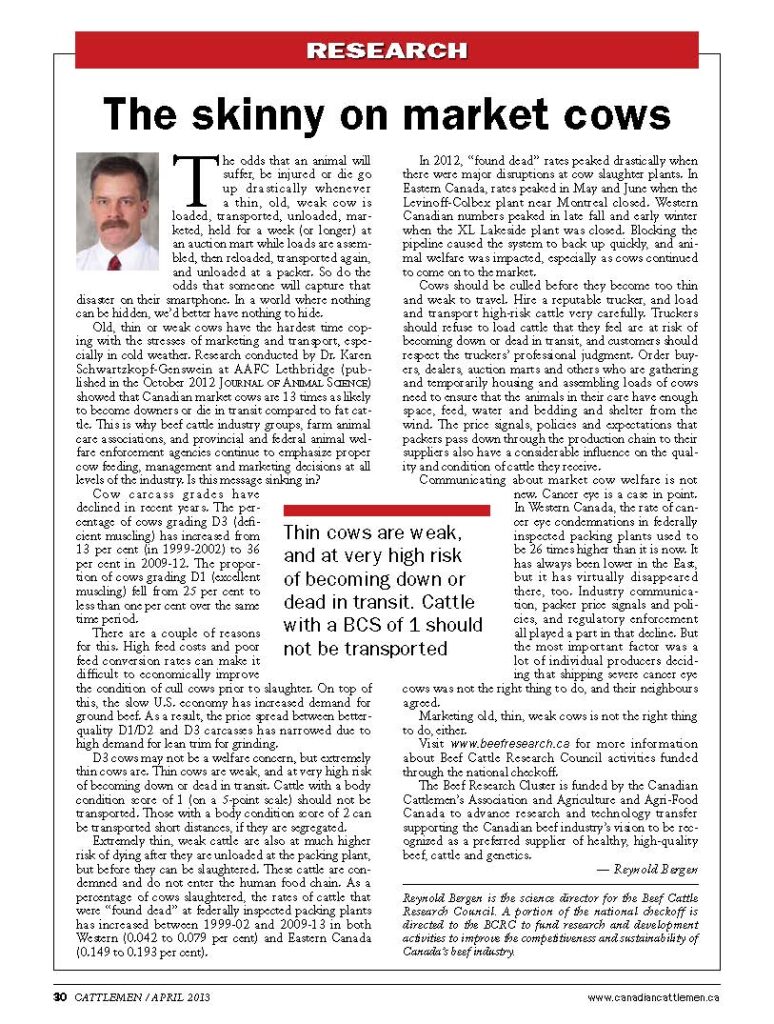The Skinny on Market Cows
This article written by Dr. Reynold Bergen, BCRC Science Director, originally appeared in the April 2013 issue of Canadian Cattlemen magazine and is reprinted with permission.

The odds that an animal will suffer, be injured or die go up drastically whenever a thin, old, weak cow is loaded, transported, unloaded, marketed, held for a week (or longer) at an auction mart while loads are assembled, then reloaded, transported again, and unloaded at a packer. So do the odds that someone will capture that disaster on their smartphone. In a world where nothing can be hidden, we’d better have nothing to hide.
Old, thin or weak cows have the hardest time coping with the stresses of marketing and transport, especially in cold weather. Research conducted by Dr. Karen Schwartzkopf-Genswein at AAFC Lethbridge (published in the October 2012 Journal of Animal Science) showed that Canadian market cows are 13 times as likely to become downers or die in transit compared to fat cattle. This is why beef cattle industry groups, farm animal care associations, and provincial and federal animal welfare enforcement agencies continue to emphasize proper cow feeding, management and marketing decisions at all levels of the industry. Is this message sinking in?
Cow carcass grades have declined in recent years. The percentage of cows grading D3 (deficient muscling) has increased from 13 per cent (in 1999-2002) to 36 per cent in 2009-12. The proportion of cows grading D1 (excellent muscling) fell from 25 per cent to less than one per cent over the same time period.
There are a couple of reasons for this. High feed costs and poor feed conversion rates can make it difficult to economically improve the condition of cull cows prior to slaughter. On top of this, the slow U.S. economy has increased demand for ground beef. As a result, the price spread between better quality D1/D2 and D3 carcasses has narrowed due to high demand for lean trim for grinding.
D3 cows may not be a welfare concern, but extremely thin cows are. Thin cows are weak, and at very high risk of becoming down or dead in transit. Cattle with a body condition score of 1 (on a 5-point scale) should not be transported. Those with a body condition score of 2 can be transported short distances, if they are segregated.
Extremely thin, weak cattle are also at much higher risk of dying after they are unloaded at the packing plant, but before they can be slaughtered. These cattle are condemned and do not enter the human food chain. As a percentage of cows slaughtered, the rates of cattle that were “found dead” at federally inspected packing plants has increased between 1999-02 and 2009-13 in both Western (0.042 to 0.079 per cent) and Eastern Canada (0.149 to 0.193 per cent).
In 2012, “found dead” rates peaked drastically when there were major disruptions at cow slaughter plants. In Eastern Canada, rates peaked in May and June when the Levinoff-Colbex plant near Montreal closed. Western Canadian numbers peaked in late fall and early winter when the XL Lakeside plant was closed. Blocking the pipeline caused the system to back up quickly, and animal welfare was impacted, especially as cows continued to come on to the market.
Cows should be culled before they become too thin and weak to travel. Hire a reputable trucker, and load and transport high-risk cattle very carefully. Truckers should refuse to load cattle that they feel are at risk of becoming down or dead in transit, and customers should respect the truckers’ professional judgment. Order buyers, dealers, auction marts and others who are gathering and temporarily housing and assembling loads of cows need to ensure that the animals in their care have enough space, feed, water and bedding and shelter from the wind. The price signals, policies and expectations that packers pass down through the production chain to their suppliers also have a considerable influence on the quality and condition of cattle they receive.
Communicating about market cow welfare is not new. Cancer eye is a case in point. In Western Canada, the rate of cancer eye condemnations in federally inspected packing plants used to be 26 times higher than it is now. It has always been lower in the East, but it has virtually disappeared there, too. Industry communication, packer price signals and policies, and regulatory enforcement all played a part in that decline. But the most important factor was a lot of individual producers deciding that shipping severe cancer eye cows was not the right thing to do, and their neighbours agreed.
Marketing old, thin, weak cows is not the right thing to do, either.
We welcome your questions, comments and suggestions. Contact us directly at [email protected] or generate public discussion by posting your thoughts below.
Stay connected by following us on Twitter @BeefResearch, liking us on Facebook, and subscribing to our YouTube Channel.
Click here to subscribe and receive email notifications when new content is posted on the BCRC Blog.